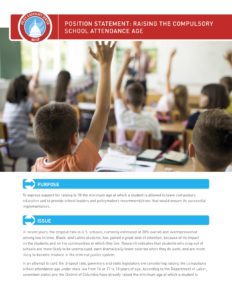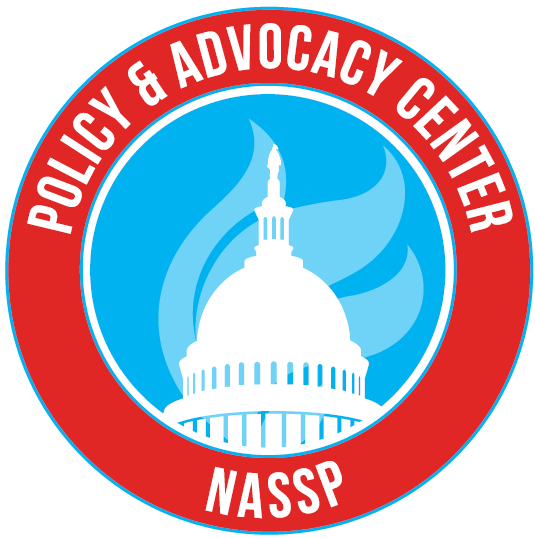To express support for raising to 18 the minimum age at which a student is allowed to leave compulsory education and to provide school leaders and policymakers recommendations that would ensure its successful implementation.
In recent years, the dropout rate in U.S. schools, currently estimated at 20% overall and overrepresented among low income, Black, and Latino students, has gained a great deal of attention, because of its impact on the students and on the communities in which they live. Research indicates that students who drop out of schools are more likely to be unemployed, earn dramatically lower salaries when they do work, and are more likely to become involved in the criminal justice system.
In an attempt to curb the dropout rate, governors and state legislators are considering raising the compulsory school attendance age under state law from 16 or 17 to 18 years of age. According to the Department of Labor, seventeen states and the District of Columbia have already raised the minimum age at which a student is legally allowed to leave compulsory education to 18. Thirteen more states are considering legislation to raise the compulsory school attendance age. The trend continues to grow as governors and state legislators consider the impact of the dropout on tax revenues in the context of an economic recession. Other countries are experiencing the same trend toward a higher compulsory school attendance age.
Opponents of this policy argue that:
• It interferes with parents’ rights to make educational choices for their children.
• It raises the burden on taxpayers and increases the cost of education.
• It represents an intrusion of the government into the lives of individuals.
• It fails to retain students who are already disengaged from their schools.
• It creates disruptions in the classroom (by students who are forced to stay in school against their will).
Supporters of this policy argue that:
• Coupled with supports for struggling students, it curtails the dropout rate (according to one study, 25% of potential dropouts remain in school because of compulsory schooling laws).
• It enables students to earn higher wages in the future (because they attend school longer).
• It affords students additional benefits, such as better health and better satisfaction with their lives.
• It reflects the realities of the 21st century, with an increased need for higher levels of education.
• It increases the prosperity of the states and the nation.
• It promotes social mobility by enabling students of poverty to stay in school longer and complete their education.
Consistent with its efforts to advance student achievement for all and close the achievement gap, NASSP affirms its support for raising the minimum age at which a student is allowed to leave compulsory education to 18, provided the following recommendations are implemented.
Guiding Principles
- NASSP believes that all students should graduate from high school with the skills to help them succeed in postsecondary education and the workplace.
- In a 2007 Achievement Gap position statement, NASSP affirmed its commitment to closing the achievement gap and offered recommendations to help policymakers and school leaders address it.
- Breaking Ranks II and Breaking Ranks in the Middle provide school leaders with a framework for improving the performance of each student by implementing best practices through collaborative leadership and professional learning communities; creating relevance through personalizing the environment; and addressing issues of rigor through curriculum, instruction, and assessment.
- In the February 2009 position statement Preparing All Students for Postsecondary Success, NASSP expressed support for challenging graduation requirements and provided recommendations for federal, state, and local policymakers to help schools ensure that all students meet those high standards.
- NASSP has identified a number of high-achieving middle level and high schools serving large numbers of low-income students. Access to rigorous coursework for all coupled with intensive and personalized supports are key components of Breakthrough Schools. Those schools offer valuable lessons on how they raised expectations and supported their students in the process.
- NASSP has been a long-time supporter of policies that seek to promote equity and excellence, including the work of Pathways to College Network, the Data Quality Campaign, Adolescent Literacy, National Standards and Assessments, the National Forum to Accelerate Middle Grades Reform, and the National High School Alliance.
Recommendations
Federal Leaders
Create a separate funding stream to improve student achievement in middle level and high schools, reduce the number of high school dropouts, and ensure that all students graduate from high school with the skills they need to succeed in college and the workforce.
State and District Leaders
Make every effort to increase the maximum compulsory age for school attendance to 18 for all students who have not already completed the requirements for a high school diploma.
Implement a systemic transition plan for all students and encourage collaboration between elementary, middle level, and high schools.
Target resources to middle level and high schools with high student-mobility rates and significant proportions of low-income students, English-language learners, students with disabilities, and low-achieving students to help all students meet high expectations.
Provide funding for graduation coaches, counselors who focus solely on at-risk students. They monitor students’ academic progress and attendance and work with teachers to identify those who are falling behind or at risk of doing so. Graduation coaches also focus on getting parents involved and will make home or workplace visits with parents.
Provide at-risk students with nonmonetary incentives for staying in school.
Provide funding and technical assistance to help schools address the educational and social needs of students who would otherwise be tempted to drop out prior to their 18th birthday.
Provide incentives to high schools that increase their graduation rates and to middle schools that increase the number of promoted students who are adequately prepared for high school.
Provide ongoing and targeted professional development to teachers and school leaders to increase their capacity to engage students in their own education.
Build a dropout recovery system for older students who are willing to go back to school to complete their education.
Implement a significant literacy initiative that supports students from early childhood through their high school years.
Allow schools to give some students, particularly English-language learners and students with disabilities, more time to complete graduation requirements.
Ensure that students have access to academic supports that will help them stay on track toward graduation, including:
- Challenging core curricula at the middle level that are aligned with the high school curricula and will help students get on target for college and career readiness by the end of grade 8.
- Counseling services for middle level and high school students that provide information and assistance about the requirements for high school graduation, college admission, and career success.
- Personalized academic plans to support completion of middle level requirements and progress toward graduation.
- Targeted and tiered interventions for middle level and high school students who are falling behind.
- Online learning opportunities.
- Extended learning time during the school day, week, and year.
- Job shadowing, internships, and community service.
- In-school and community-based social supports, such as counselors, social workers, and mental health services.
School Leaders
Create small units in their schools, where anonymity is eliminated.
Create a personal plan for progress for each student to support his or her talents and interests. Review the plan often to ensure that the school takes individual needs into consideration.
Offer career and technical education or curriculum-based service learning.
Assign a personal adult advocate to each student.
Engage families as partners in their students’ education.
Help coordinate the delivery of physical and mental health and social services for students in conjunction with agencies in the community.
Provide intensive interventions to students who are at risk of dropping out.
Promote policies and practices that recognize diversity and offer substantive, ongoing professional development to help educators appreciate issues of diversity.
Promote and convey a sense of caring so that students know that teachers have a stake in student learning.
References
Christie, K. (2007). The complexity of compulsory attendance. Phi Delta Kappan. 88(5), 341–3.
Compulsory Education. (n,.d.). Retieved from http://www.ncsl.org/IssuesResearch/Education/CompulsoryEducationOverview/tabid/12943/Default.aspx
NASSP. (2004). Breaking Ranks II: Strategies for leading high school reform. Reston, VA: Author.
NASSP. (2006). Breaking Ranks in the Middle: Strategies for leading middle level reform. Reston, VA: Author.
New South Wales Government. (2008). Raising the school leaving age. Consultation Paper.
Princiotta, D., & Reyna, R. (2009). Achieving graduation for all. A governor’s guide to dropout prevention and recovery. Washington, DC: Center for Best Practices. National Governors Association.


